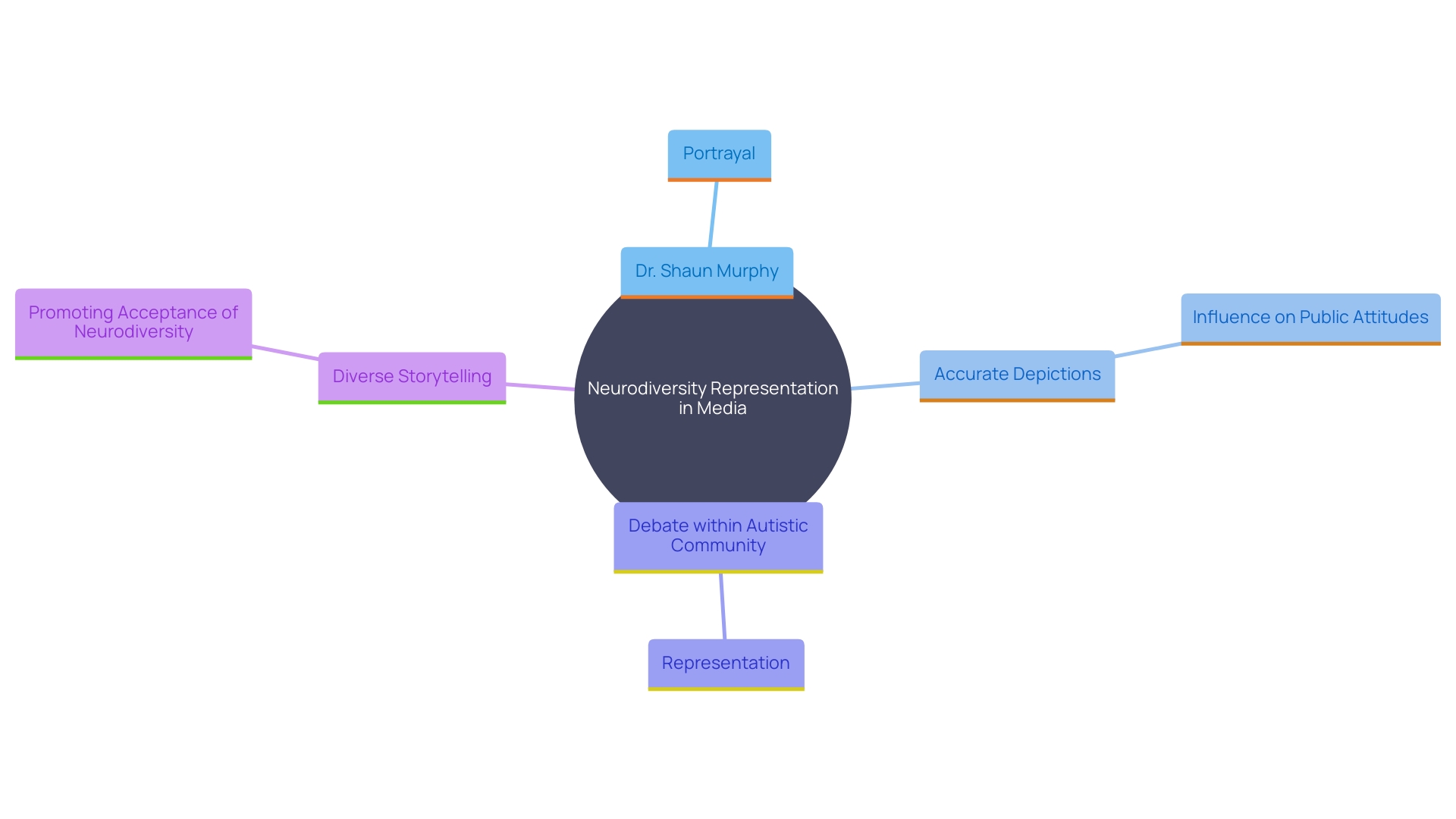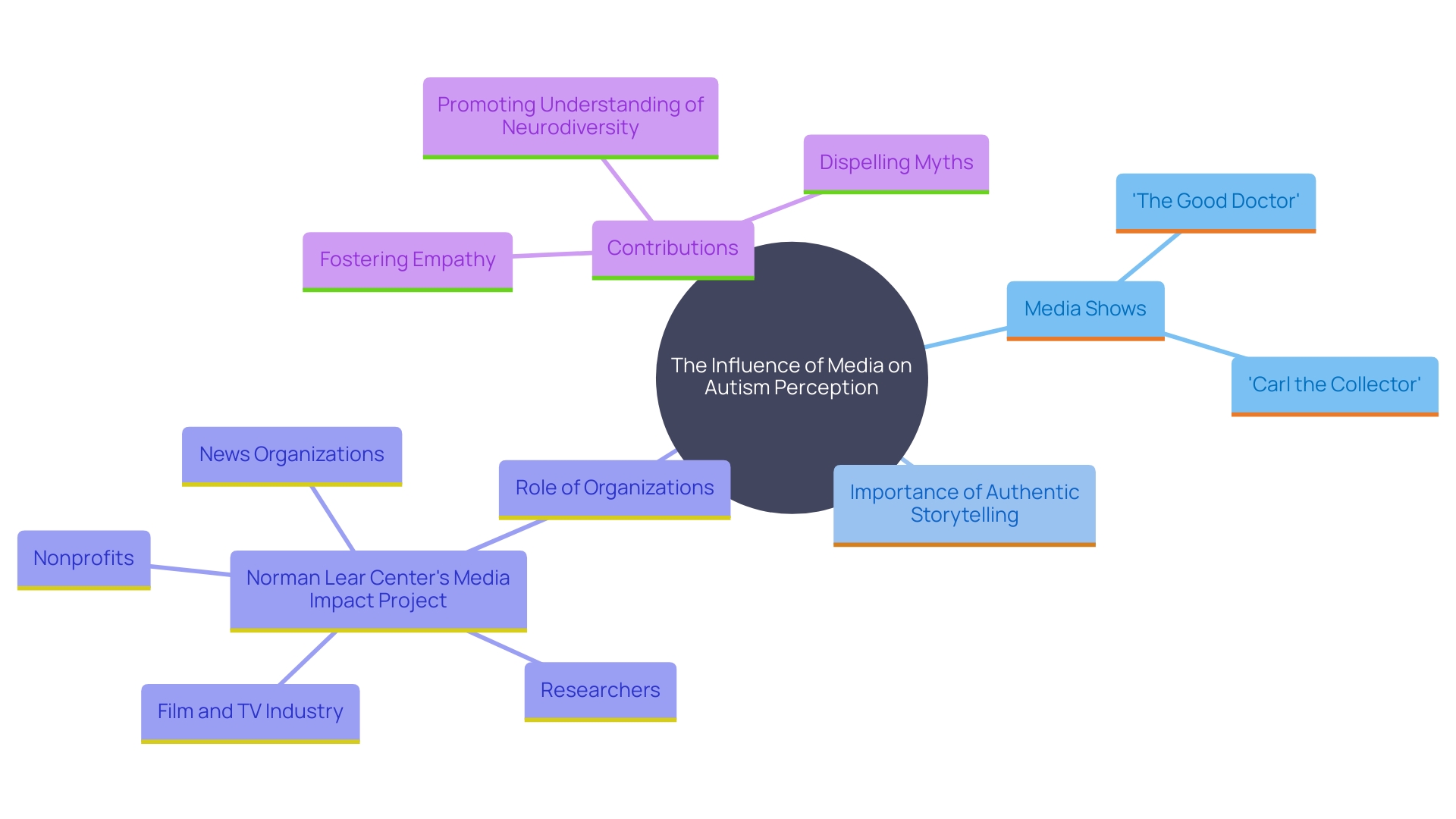Introduction
Freddie Highmore's compelling portrayal of Dr. Shaun Murphy in "The Good Doctor" has transcended entertainment, becoming a powerful vehicle for autism representation. This acclaimed series offers a nuanced depiction of a gifted surgical resident with autism and savant syndrome, shedding light on both the extraordinary talents and the unique challenges faced by individuals on the spectrum. Such authentic portrayals are pivotal in fostering understanding, empathy, and awareness among audiences, as evidenced by research from the Norman Lear Center's Media Impact Project.
While "The Good Doctor" has sparked essential conversations and boosted visibility around autism, it also faces criticism for potentially oversimplifying the spectrum. This ongoing debate underscores the need for more diverse and accurate representations in media to ensure all voices within the autistic community are heard and respected. As society moves towards greater inclusivity, shows like "The Good Doctor" and upcoming productions such as PBS Kids' "Carl the Collector" exemplify the growing commitment to celebrating neurodiversity.
This article delves into the impact of "The Good Doctor" on autism awareness, the strengths and criticisms of its portrayal, and the broader implications of media representation in shaping public perception.
The Good Doctor: A Platform for Autism Representation
Freddie Highmore stars as Dr. Shaun Murphy in the critically acclaimed series "The Good Doctor." This show has become an essential platform for showcasing individuals on the spectrum, depicting Shaun as a talented surgical resident with savant syndrome. Through his character, the series effectively showcases the extraordinary talents and unique challenges faced by individuals on the spectrum. Such representation plays a crucial role in enhancing public understanding of autism, fostering empathy, and raising awareness.
The impact of authentic portrayals in media cannot be overstated. According to the Norman Lear Center's Media Impact Project, accurate depictions of mental health and neurodiversity in entertainment significantly influence viewers' attitudes and actions. Furthermore, the presence of neurodiverse characters in productions like 'The Good Doctor' and the upcoming PBS Kids series 'Carl the Collector' underscores the increasing dedication to inclusive storytelling. These efforts are essential in promoting a broader acceptance and celebration of neurodiversity.
However, it's important to recognize the ongoing debate within the autistic community regarding the portrayal of this condition on screen. While some praise "The Good Doctor" for its visibility, others criticize it for oversimplifying and misrepresenting the spectrum. For instance, David Moloney from Autism Ontario observes that the show frequently emphasizes the condition too much, which can result in misconceptions about it. This underscores the need for more diverse and accurate portrayals in media to ensure all voices within the autistic community are heard and respected.

Impact of The Good Doctor on Autism Awareness
'Since its debut, "The Good Doctor" has ignited important discussions about the condition, reaching a varied audience that includes both those knowledgeable and those unaware of it.'. The production’s success has significantly boosted the visibility of autism-related issues, encouraging society to discuss the importance of acceptance and understanding. Through its compelling storytelling, it has helped break down stereotypes and promote inclusivity. As emphasized by the Norman Lear Center's Media Impact Project, "genuine representations of mental health in entertainment can have a significant effect on how viewers care for themselves and each other." Furthermore, the development of programs like PBS Kids' "Carl the Collector," showcasing a main character with a developmental difference, further illustrates the increasing initiative to honor neurodiversity and promote a society where it is acknowledged and welcomed. These forms of representation are essential in changing societal attitudes and promoting a more inclusive environment.
Portrayal of Autism in The Good Doctor: Strengths and Criticisms
Freddie Highmore's portrayal of Dr. Shaun Murphy in The Good Doctor has garnered significant praise for its authenticity and emotional depth. However, the character's savant abilities have faced criticism for potentially reinforcing misconceptions about the condition, suggesting that all individuals on the spectrum possess extraordinary talents. This risk of misrepresentation is not unique to The Good Doctor and reflects a broader issue in media portrayals of individuals on the spectrum, where characters are often depicted with extreme traits that do not reflect the diversity of the spectrum. For instance, the 1998 thriller Mercury Rising showcases a young autistic boy with exceptional code-breaking skills, promoting a limited perspective of the condition.
Regardless of these worries, The Good Doctor's commitment to highlighting Shaun’s journey offers a space for addressing both the difficulties and victories faced by many individuals on the spectrum. This aligns with the show's broader impact on public perceptions, as it invites viewers to rethink their understanding of autism. As noted by Meryl Alper, autistic individuals are often used to project societal beliefs rather than being recognized for their unique experiences and capacities. This highlights the significance of varied and precise portrayals in communication.
Additionally, the incorporation of neurodiverse viewpoints in content creation, such as the forthcoming PBS Kids series Carl the Collector, illustrates a favorable change towards more inclusive and representative storytelling. As Zachariah OHora, the series creator, highlights, showcasing neurodiverse characters helps foster a world where neurodiversity is celebrated and understood as part of the human experience. This shift towards genuine portrayal is vital in tackling the stereotypes and misconceptions that have long enveloped developmental disorders in visual communication.
Freddie Highmore's Contribution to Autism Representation
Freddie Highmore's dedication to genuine portrayal goes further than his engaging performances; he actively engages in conversations about awareness regarding developmental disorders. His portrayal of Dr. Shaun Murphy in The Good Doctor is both nuanced and respectful, resonating deeply with viewers. Highmore highlights the significance of precise and varied portrayal in communication, supporting narratives that truly mirror the diverse experiences of individuals on the spectrum. This corresponds with the wider campaign for inclusion in media, as evident in projects like the Marvels of Media Festival, which honors the contributions of autistic creators, and new shows such as PBS Kids' Carl the Collector, which includes neurodiverse characters both on screen and behind the scenes. Highmore's support and the increasing portrayal of autistic characters in various forms help cultivate a deeper comprehension and acceptance of the condition in society.
The Importance of Authentic Representation in Media
Genuine portrayal in media plays a crucial role in shaping public perception of the condition. When characters like Shaun Murphy are depicted with complexity and depth, it encourages viewers to see individuals with developmental differences as whole people rather than mere stereotypes. This authenticity fosters understanding and acceptance, paving the way for a more inclusive society. The Norman Lear Center's Media Impact Project highlights how entertainment influences our thoughts, attitudes, and actions, reinforcing how vital accurate portrayals are. For instance, PBS Kids' new program 'Carl the Collector' highlights a raccoon with a unique way of thinking and his diverse companions, illustrating how inclusive stories can foster compassion and insight. As Zachariah OHora, the creator of the program, states, 'My hope for Carl and his diverse group of Fuzzytown friends is that they will inspire neurodiverse and neurotypical kids alike to foster a world in which neurodiversity is not only recognized as a benefit to society, but is celebrated.' 'These efforts in media portrayal contribute significantly to changing public knowledge and attitudes towards individuals on the spectrum, making inclusion and acceptance a celebrated norm.'.
Challenging Stereotypes and Promoting Inclusivity
"The Good Doctor" takes an active stance against stereotypes by showcasing Shaun's capabilities and resilience. By portraying his experiences in both personal and professional realms, the show challenges the one-dimensional narratives often linked to the condition. This approach promotes inclusivity and encourages audiences to embrace diversity in all its forms. Given the current prevalence of the condition at 1 in 36, authentic representation is crucial. As the series progresses, it also introduces new characters like Charlene “Charlie” Lukaitis, a medical student with autism, further enriching the narrative with diverse perspectives. Such portrayals not only foster acceptance but also highlight the untapped potential of the autistic community. This corresponds with wider media initiatives, such as PBS Kids' recent program "Carl the Collector," which seeks to honor neurodiversity and inform young viewers. By integrating neurodiverse characters and creators, these productions contribute to a more inclusive environment for media

The Role of Media in Shaping Public Perception of Autism
Media wields a significant influence on public perception, with shows like 'The Good Doctor' playing a crucial role in educating viewers about autism. By portraying authentic stories, media helps dispel myths and fosters a more informed society. A recent example is PBS Kids' new series 'Carl the Collector,' which features a neurodiverse cast and aims to celebrate neurodiversity as a societal benefit. Such representations inspire empathy and a deeper understanding of the challenges faced by individuals on the spectrum. The Norman Lear Center's Media Impact Project emphasizes the concrete influence of these representations, showcasing how they mold public perceptions and understanding of the condition. When Emmy Peach shared her personal experience about neurodevelopmental differences at TEDxUGA, it not only reached over 100,000 viewers but also profoundly affected her own family, illustrating the significant influence of storytelling on actual lives.

Future Directions for Autism Representation in Media
As conversations regarding this condition progress, the future of media depiction appears encouraging. There's a growing acknowledgment of the necessity for varied narratives that reflect the broad spectrum of experiences within the community. PBS Kids is making a significant move by creating 'Carl the Collector,' an animated series showcasing a main character with developmental differences and his neurodiverse friends. According to Zachariah OHora, the creator of the show, 'My hope for Carl and his diverse group of Fuzzytown friends is that they will inspire neurodiverse and neurotypical kids alike to foster a world in which neurodiversity is not only recognized as a benefit to society but is celebrated as exemplifying the full spectrum of what it means to be human.'
Additionally, the upcoming report by the Norman Lear Center's Media Impact Project aims to shed light on how entertainment and news influence public perception and actions. This research highlights the transformative role communication channels can play in advocacy and awareness by offering genuine and diverse representations of the autism community. As we continue to see more inclusive media projects, the impact on societal attitudes and the support for autistic individuals will likely become more profound and far-reaching.
Conclusion
The portrayal of autism in media, particularly through shows like "The Good Doctor," serves as a critical platform for enhancing public understanding and acceptance of neurodiversity. By showcasing the complexities and capabilities of characters like Dr. Shaun Murphy, the series not only raises awareness but also invites audiences to engage in meaningful conversations about autism. This representation plays a vital role in challenging stereotypes and promoting inclusivity, demonstrating that individuals on the spectrum possess a wide range of experiences and talents.
While the impact of "The Good Doctor" has been significant in promoting visibility and sparking dialogue, it is essential to acknowledge the ongoing discussions surrounding the accuracy of such representations. Critiques highlight the need for more nuanced portrayals that reflect the diversity within the autism spectrum. As the media landscape evolves, the emergence of new projects, such as PBS Kids' "Carl the Collector," signals a promising shift towards more authentic narratives that celebrate neurodiversity and include varied perspectives.
Ultimately, the responsibility lies with creators and audiences alike to advocate for diverse and accurate representations in media. By supporting shows that foster understanding and acceptance, society can work towards a future where neurodiversity is not only recognized but celebrated as a vital aspect of the human experience. The journey towards inclusivity and awareness continues, and every step taken in media representation contributes to a more compassionate and informed world.




